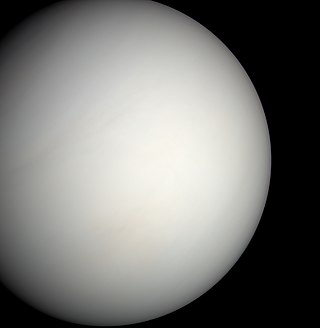
Venus is the second planet from the Sun. It is a terrestrial planet and is the closest in mass and size to its orbital neighbour Earth. Venus is notable for having the densest atmosphere of the terrestrial planets, composed mostly of carbon dioxide with a thick, global sulfuric acid cloud cover. At the surface it has a mean temperature of 737 K and a pressure of 92 times that of Earth's at sea level. These conditions are extreme enough to compress carbon dioxide into a supercritical state close to Venus's surface.
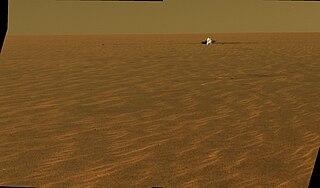
The Meridiani Planum (alternately Meridiani plain, Meridiani plains, Terra Meridiani, or Terra Meridiani plains) is either a large plain straddling the equator of Mars and covered with a vast number of spherules containing a lot of iron oxide or a region centered on this plain that includes some adjoining land. The plain sits on top of an enormous body of sediments that contains a lot of bound water. The iron oxide in the spherules is crystalline (grey) hematite (Fe2O3).
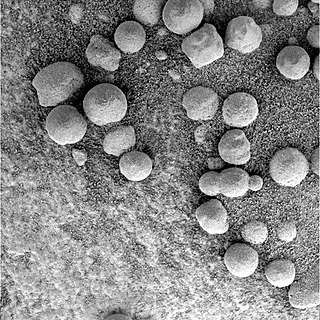
Martian spherules (also known as hematite spherules, blueberries, & Martian blueberries) are small spherules (roughly spherical pebbles) that are rich in an iron oxide (grey hematite, α-Fe2O3) and are found at Meridiani Planum (a large plain on Mars) in exceedingly large numbers.

Venera 14 was a probe in the Soviet Venera program for the exploration of Venus.

Ishtar Terra is the second largest of the three continental terrae regions on the planet Venus, the others being Aphrodite Terra and Lada Terra.

Maxwell Montes is a mountain range on the planet Venus, of which Skadi Mons is the highest.

The geology of Venus is the scientific study of the surface, crust, and interior of the planet Venus. Within the Solar System, it is the one nearest to Earth and most like it in terms of mass, but has no magnetic field or recognizable plate tectonic system. Much of the ground surface is exposed volcanic bedrock, some with thin and patchy layers of soil covering, in marked contrast with Earth, the Moon, and Mars. Some impact craters are present, but Venus is similar to Earth in that there are fewer craters than on the other rocky planets that are largely covered by them. This is due in part to the thickness of the Venusian atmosphere disrupting small impactors before they strike the ground, but the paucity of large craters may be due to volcanic re-surfacing, possibly of a catastrophic nature. Volcanism appears to be the dominant agent of geological change on Venus. Some of the volcanic landforms appear to be unique to the planet. There are shield and composite volcanoes similar to those found on Earth, although these volcanoes are significantly shorter than those found on Earth or Mars. Given that Venus has approximately the same size, density, and composition as Earth, it is plausible that volcanism may be continuing on the planet today, as demonstrated by recent studies.

Cleopatra, initially called Cleopatra Patera, is an impact crater on Venus, in Maxwell Montes.

Mead is an impact crater on Venus named in honor of the cultural anthropologist Margaret Mead.

Olympia Undae is a vast dune field in the north polar region of the planet Mars. It consists of a broad "sand sea" or erg that partly rings the north polar plateau from about 120° to 240°E longitude and 78° to 83°N latitude. Stretching about 1,100 km (680 mi) across and covering an area of 470,000 km2, Olympia Undae is the largest continuous dune field on Mars. It is similar in size to the Rub' Al Khali in the Arabian Peninsula, the largest active erg on Earth.
Lakshmi is one of the major Goddess in Hinduism may also refer to: Goddess Lakshmi
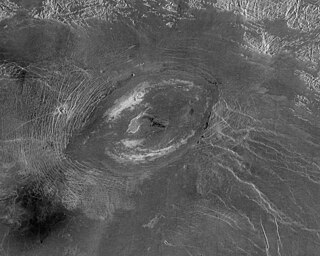
Sacajawea Patera is a large, elongate caldera located in Western Ishtar Terra on the smooth plateau of Lakshmi Planum, on the planet Venus. The image is centred at 64.5 degrees North latitude and 337 degrees East longitude. It is approximately 420 km (260 mi) wide at the base. Sacajawea is a depression approximately 1–2 kilometres (0.62–1.24 mi) deep and 120 by 215 kilometres in diameter; it is elongate in a southwest–northeast direction. The depression is bounded by a zone of circumferential curvilinear structures interpreted to be graben and fault scarps. These structures are spaced 0.5–4 kilometers apart, are 0.6–4.0 kilometers in width and up to 100 km (62 mi) in length. Extending up to approximately 140 km (87 mi) in length from the southeast of the patera is a system of linear structures thought to represent a flanking rift zone along which the lateral injection and eruption of magma may have occurred. A shield edifice 12 km (7.5 mi) in diameter with a prominent central pit lies along the trend of one of these features.
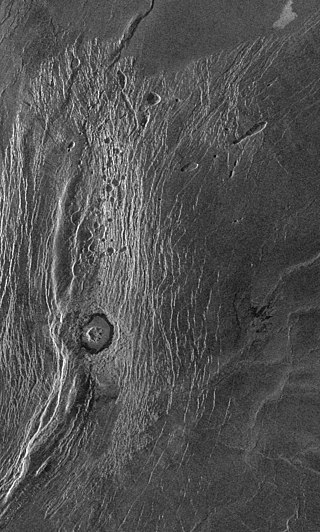
Akna Montes are a mountain range on Venus centered at 68.9°N, 318.2°E and stretching 830 km long.

Baʽhet Corona is a corona on the surface of Venus. About 230 kilometres (140 mi) long and 150 kilometres (93 mi) across, it is adjacent to Onatah Corona. Both features are surrounded by a ring of ridges and troughs, which in places cut more radially-oriented fractures. The centers of the features also contain radial fractures as well as volcanic domes and flows. Coronae are thought to form due to the upwelling of hot material from deep in the interior of Venus. The two coronae may have formed at the same time over a single upwelling, or may indicate movement of the upwelling or the upper layers of the planet to the west over time. A 'pancake' dome, similar to low-relief domes see in the southern hemisphere, is located just to the southwest of Bahet.

Onatah Corona is a corona on Venus adjacent to Ba'het Corona. Both features are surrounded by a ring of ridges and troughs, which in places cut more radially-oriented fractures. The centers of the features also contain radial fractures as well as volcanic domes and flows. Coronae are thought to form due to the upwelling of hot material from deep in the interior of Venus. The two coronae may have formed at the same time over a single upwelling, or may indicate movement of the upwelling or the upper layers of the planet to the west over time.

Endeavour is an impact crater located in the Meridiani Planum extraterrestrial plain within the Margaritifer Sinus quadrangle (MC-19) region of the planet Mars. Endeavour is about 22 kilometers (14 mi) in diameter. Using Mars Reconnaissance Orbiter data, phyllosilicate-bearing outcrops have been detected along its rim. These minerals may have formed under wet conditions in a low-acidic environment during the early history of Mars. There are raised rim segments to the north, east, and southwest. The rim has become worn, rounded and degraded, with infilling of plains material in a manner similar to the Victoria crater.

Hesperia Planum is a broad lava plain in the southern highlands of the planet Mars. The plain is notable for its moderate number of impact craters and abundant wrinkle ridges. It is also the location of the ancient volcano Tyrrhena Mons. The Hesperian time period on Mars is named after Hesperia Planum.
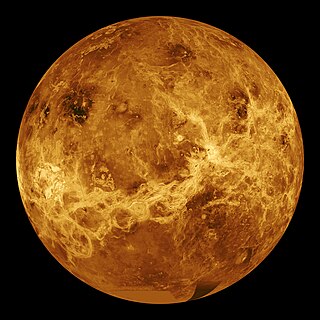
NASA's Magellan spacecraft mission discovered that Venus has a geologically young surface with a relatively uniform age of 500±200 Ma. The age of Venus was revealed by the observation of over 900 impact craters on the surface of the planet. These impact craters are nearly uniformly distributed over the surface of Venus and less than 10% have been modified by plains of volcanism or deformation. These observations indicate that a catastrophic resurfacing event took place on Venus around 500 Ma, and was followed by a dramatic decline in resurfacing rate. The radar images from the Magellan missions revealed that the terrestrial style of plate tectonics is not active on Venus and the surface currently appears to be immobile. Despite these surface observations, there are numerous surface features that indicate an actively convecting interior. The Soviet Venera landings revealed that the surface of Venus is essentially basaltic in composition based on geochemical measurements and morphology of volcanic flows. The surface of Venus is dominated by patterns of basaltic volcanism, and by compressional and extensional tectonic deformation, such as the highly deformed tesserae terrain and the pancake like volcano-tectonic features known as coronae. The planet's surface can be broadly characterized by its low lying plains, which cover about 80% of the surface, 'continental' plateaus and volcanic swells. There is also an abundance of small and large shield volcanoes distributed over the planet's surface. Based on its surface features, it appears that Venus is tectonically and convectively alive but has a lithosphere that is static.
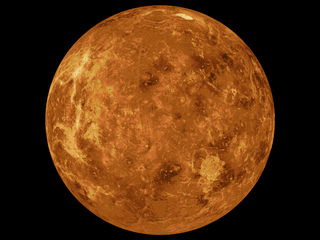
The mapping of Venus refers to the process and results of human description of the geological features of the planet Venus. It involves surface radar images of Venus, construction of geological maps, and the identification of stratigraphic units, volumes of rock with a similar age.

Leviathan Patera is a major cryovolcanic caldera on Neptune's largest moon Triton. Discovered by the Voyager 2 spacecraft in 1989, Leviathan Patera is located in Monad Regio and within Cipango Planum's western regions. Leviathan Patera is approximately 80 kilometers in diameter and may be the center of one of the largest cryovolcanic or volcanic edifices in the Solar System.



















